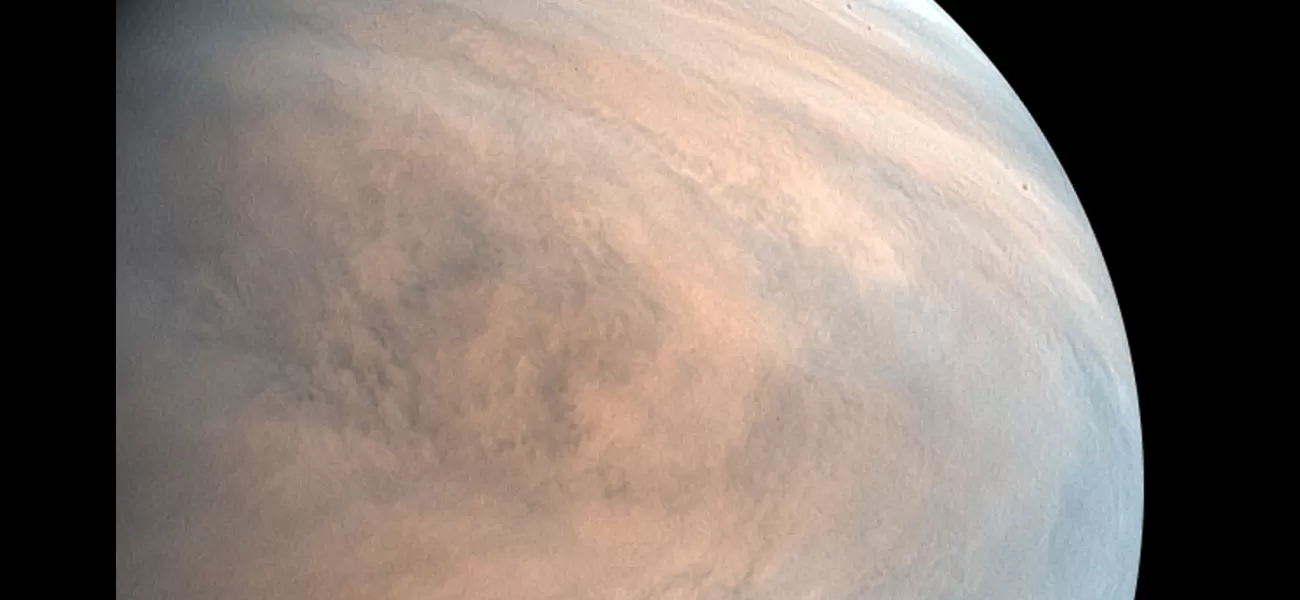New evidence supports previous claims of potential life on Venus, causing controversy among scientists.
A controversial discovery of phosphine gas in the clouds of Venus four years ago sparked debate and subsequent observations that did not support the initial findings.
July 30th 2024.

Four years ago, a group of scientists made a surprising discovery in the clouds of Venus - they found a gas called phosphine, which on Earth is a sign of life. This caused quite a bit of controversy, as subsequent observations failed to confirm their findings. However, this same team has now returned with even more evidence to support their initial discovery. They presented their findings for the first time on July 17 at a conference of the Royal Astronomical Society in Hull, England. The data they have collected will form the foundation for future scientific studies, and the team has already begun this work.
In their latest observations, the researchers have found even stronger proof that phosphine does indeed exist in the clouds of Venus, which is our closest planetary neighbor. It's often referred to as Earth's "evil twin," as it shares a similar size to our planet but has extreme surface temperatures that can reach levels high enough to melt lead. The planet's clouds are also made of corrosive sulfuric acid. These challenging conditions have made it difficult for scientists to gather data and study Venus in depth.
But this time, the team was able to benefit from a new receiver that was installed on one of their observation instruments - the James Clerk Maxwell Telescope in Hawaii. This has given them more confidence in their findings and has provided them with a wealth of new data to analyze. Dave Clements, a reader in astrophysics at Imperial College London, explained, "There's also a lot more data this time around. We conducted three observation campaigns and in just one of them, we collected 140 times more data than we did in the original detection. And what we've seen so far indicates that we have once again detected the presence of phosphine."
During the conference, another team, which Clements is also a part of, presented evidence of the existence of another gas - ammonia. He believes this discovery is even more significant than the detection of phosphine. He stated, "We're not ready to make any definitive statements yet, but if there is indeed life on Venus that is producing phosphine, we have no idea why it would be doing so. However, if there is life on Venus that is producing ammonia, we do have a plausible explanation for why this may be happening."
The discussion about the potential discovery of life on Venus has sparked much excitement and curiosity. On Earth, phosphine is a toxic gas with a foul smell that is produced by bacteria or decaying organic matter. Ammonia, on the other hand, is a gas with a pungent odor that is naturally found in the environment and is mostly produced by bacteria during the decomposition process of plant and animal waste. Clements explained, "Phosphine has been detected in the atmosphere of Saturn, but this was not unexpected as Saturn is a gas giant with a high concentration of hydrogen. Therefore, any hydrogen-based compounds, such as phosphine or ammonia, are predominant there."
However, rocky planets like Earth, Venus, and Mars have atmospheres dominated by oxygen due to the loss of hydrogen during their formation. So finding these gases on Venus is a surprising discovery. Clements stated, "Based on what we know, these gases should not be present on Venus. Phosphine and ammonia have been proposed as potential biomarkers, even on exoplanets. Therefore, finding them in the atmosphere of Venus is very intriguing. When we first published our findings in 2020, it was a huge surprise to everyone."
Since then, other studies have challenged the team's results, suggesting that the detected phosphine was actually sulfur dioxide, a more common and expected gas on Venus. Data collected by other instruments, such as the Venus Express spacecraft, the NASA Infrared Telescope Facility, and the SOFIA airborne observatory, also failed to confirm the presence of phosphine. However, Clements and his team believe that their new data, collected by the Atacama Large Millimeter/submillimeter Array (ALMA), rules out the possibility of sulfur dioxide being a contaminant. They also believe that the lack of phosphine in other observations is due to timing.
Clements explained, "We have found that all of our observations that detected phosphine were taken during the transition from night to day on Venus, while all the observations that did not detect phosphine were taken during the transition from day to night. During the day, ultraviolet light from the sun can break down molecules in the upper atmosphere of Venus, so all of the phosphine is destroyed, and that's why it's not visible during that time. The only exception was the Stratospheric Observatory for Infrared Astronomy, which made observations at night. Upon further analysis of that data, we found weak traces of phosphine, which supports our theory."
Clements also mentioned unrelated research conducted by a team led by Rakesh Mogul, a professor of chemistry and biochemistry at the California State Polytechnic University, Pomona. They reanalyzed data from an old NASA probe that entered the atmosphere of Venus in 1978. He explained, "Their findings showed the presence of phosphine in the clouds of Venus at levels similar to what we have been detecting. So it's all starting to come together, but we still don't know what is causing the phosphine to appear." This ongoing research continues to fuel the excitement and mystery surrounding the possibility of finding life on Venus.
Four years ago, a groundbreaking discovery was made in the clouds of Venus - the presence of phosphine, a gas that is a strong indicator of life on Earth. However, this finding was met with skepticism and criticism as subsequent observations failed to confirm the initial results.
But now, the same team responsible for the initial discovery has returned with more data to support their findings. They recently presented their findings at a Royal Astronomical Society meeting in Hull, England on July 17. And their work has already begun to pave the way for future studies.
The data collected by the researchers provides even stronger evidence that phosphine does indeed exist in the clouds of Venus, our closest planetary neighbor. Often referred to as Earth's "evil twin," Venus shares a similar size with our planet but has extreme surface temperatures that can even melt lead. Its atmosphere is also made up of corrosive sulfuric acid clouds.
The team's work has been aided by a new receiver that was installed on one of their instruments, the James Clerk Maxwell Telescope in Hawaii. This has given them more confidence in their findings. "We also have a lot more data this time," explains Dave Clements, a reader in astrophysics at Imperial College London. "In fact, in just one observation campaign, we collected 140 times more data than we did during our original detection."
"And the data we have so far indicates that we have once again detected the presence of phosphine," he adds.
Another team, which Clements is also a part of, has also presented evidence of another gas, ammonia. Clements believes that this finding is even more significant than the discovery of phosphine. "We are still far from making any definitive statements, but if there is indeed life on Venus that is producing phosphine, we have no idea why. However, if this life is also producing ammonia, then we have a possible explanation for its purpose," he explains.
On Earth, phosphine is a toxic gas with a foul odor that is produced by decaying organic matter or bacteria. Ammonia, on the other hand, is a pungent-smelling gas that is naturally found in the environment and is produced mainly by bacteria during the decomposition process of plant and animal waste.
Clements points out that phosphine has previously been discovered in the atmosphere of Saturn, but that is not surprising as Saturn is a gas giant with a high concentration of hydrogen. However, rocky planets like Earth, Venus, and Mars have atmospheres dominated by oxygen because they lack the mass to retain the hydrogen they had during their formation. Therefore, finding these gases on Venus is unexpected.
"As per our understanding, these gases should not be present on Venus," Clements says. "Both phosphine and ammonia have been proposed as potential biomarkers, even on exoplanets. So their discovery in the atmosphere of Venus is significant in that aspect as well. When we first published our findings on phosphine in 2020, it was a surprise to many."
Subsequent studies have challenged the results, suggesting that the phosphine detected may actually be sulfur dioxide, a common gas found on Venus. Data from other instruments, such as the Venus Express spacecraft and the NASA Infrared Telescope Facility, have also failed to replicate the initial findings.
But Clements assures that the new data from the Atacama Large Millimeter/submillimeter Array (ALMA) rules out any possibility of sulfur dioxide being a contaminant. He also believes that the lack of phosphine being detected in other observations can be attributed to timing.
"It turns out that all our observations that detected phosphine were taken as Venus moved from night into day," he explains. "And all the observations that did not detect phosphine were taken as the planet moved from day into night."
During the day, the ultraviolet light from the sun can break down molecules in Venus's upper atmosphere, resulting in the absence of phosphine. "The only exception to this is the Stratospheric Observatory for Infrared Astronomy, which made observations during the night," adds Clements.
Further analysis of the data from this observation revealed weak traces of phosphine, further supporting the team's theory. Clements also mentions other research that supports their findings, led by Rakesh Mogul, a professor of chemistry and biochemistry at the California State Polytechnic University, Pomona.
Mogul reanalyzed old data from NASA's Pioneer Venus Large Probe, which entered Venus's atmosphere in 1978. "The data showed the presence of phosphine within the clouds of Venus at a level of about one part per million, which is consistent with our findings," says Clements. "So while things are starting to add up, we still do not know what is causing the production of phosphine on Venus."
In their latest observations, the researchers have found even stronger proof that phosphine does indeed exist in the clouds of Venus, which is our closest planetary neighbor. It's often referred to as Earth's "evil twin," as it shares a similar size to our planet but has extreme surface temperatures that can reach levels high enough to melt lead. The planet's clouds are also made of corrosive sulfuric acid. These challenging conditions have made it difficult for scientists to gather data and study Venus in depth.
But this time, the team was able to benefit from a new receiver that was installed on one of their observation instruments - the James Clerk Maxwell Telescope in Hawaii. This has given them more confidence in their findings and has provided them with a wealth of new data to analyze. Dave Clements, a reader in astrophysics at Imperial College London, explained, "There's also a lot more data this time around. We conducted three observation campaigns and in just one of them, we collected 140 times more data than we did in the original detection. And what we've seen so far indicates that we have once again detected the presence of phosphine."
During the conference, another team, which Clements is also a part of, presented evidence of the existence of another gas - ammonia. He believes this discovery is even more significant than the detection of phosphine. He stated, "We're not ready to make any definitive statements yet, but if there is indeed life on Venus that is producing phosphine, we have no idea why it would be doing so. However, if there is life on Venus that is producing ammonia, we do have a plausible explanation for why this may be happening."
The discussion about the potential discovery of life on Venus has sparked much excitement and curiosity. On Earth, phosphine is a toxic gas with a foul smell that is produced by bacteria or decaying organic matter. Ammonia, on the other hand, is a gas with a pungent odor that is naturally found in the environment and is mostly produced by bacteria during the decomposition process of plant and animal waste. Clements explained, "Phosphine has been detected in the atmosphere of Saturn, but this was not unexpected as Saturn is a gas giant with a high concentration of hydrogen. Therefore, any hydrogen-based compounds, such as phosphine or ammonia, are predominant there."
However, rocky planets like Earth, Venus, and Mars have atmospheres dominated by oxygen due to the loss of hydrogen during their formation. So finding these gases on Venus is a surprising discovery. Clements stated, "Based on what we know, these gases should not be present on Venus. Phosphine and ammonia have been proposed as potential biomarkers, even on exoplanets. Therefore, finding them in the atmosphere of Venus is very intriguing. When we first published our findings in 2020, it was a huge surprise to everyone."
Since then, other studies have challenged the team's results, suggesting that the detected phosphine was actually sulfur dioxide, a more common and expected gas on Venus. Data collected by other instruments, such as the Venus Express spacecraft, the NASA Infrared Telescope Facility, and the SOFIA airborne observatory, also failed to confirm the presence of phosphine. However, Clements and his team believe that their new data, collected by the Atacama Large Millimeter/submillimeter Array (ALMA), rules out the possibility of sulfur dioxide being a contaminant. They also believe that the lack of phosphine in other observations is due to timing.
Clements explained, "We have found that all of our observations that detected phosphine were taken during the transition from night to day on Venus, while all the observations that did not detect phosphine were taken during the transition from day to night. During the day, ultraviolet light from the sun can break down molecules in the upper atmosphere of Venus, so all of the phosphine is destroyed, and that's why it's not visible during that time. The only exception was the Stratospheric Observatory for Infrared Astronomy, which made observations at night. Upon further analysis of that data, we found weak traces of phosphine, which supports our theory."
Clements also mentioned unrelated research conducted by a team led by Rakesh Mogul, a professor of chemistry and biochemistry at the California State Polytechnic University, Pomona. They reanalyzed data from an old NASA probe that entered the atmosphere of Venus in 1978. He explained, "Their findings showed the presence of phosphine in the clouds of Venus at levels similar to what we have been detecting. So it's all starting to come together, but we still don't know what is causing the phosphine to appear." This ongoing research continues to fuel the excitement and mystery surrounding the possibility of finding life on Venus.
Four years ago, a groundbreaking discovery was made in the clouds of Venus - the presence of phosphine, a gas that is a strong indicator of life on Earth. However, this finding was met with skepticism and criticism as subsequent observations failed to confirm the initial results.
But now, the same team responsible for the initial discovery has returned with more data to support their findings. They recently presented their findings at a Royal Astronomical Society meeting in Hull, England on July 17. And their work has already begun to pave the way for future studies.
The data collected by the researchers provides even stronger evidence that phosphine does indeed exist in the clouds of Venus, our closest planetary neighbor. Often referred to as Earth's "evil twin," Venus shares a similar size with our planet but has extreme surface temperatures that can even melt lead. Its atmosphere is also made up of corrosive sulfuric acid clouds.
The team's work has been aided by a new receiver that was installed on one of their instruments, the James Clerk Maxwell Telescope in Hawaii. This has given them more confidence in their findings. "We also have a lot more data this time," explains Dave Clements, a reader in astrophysics at Imperial College London. "In fact, in just one observation campaign, we collected 140 times more data than we did during our original detection."
"And the data we have so far indicates that we have once again detected the presence of phosphine," he adds.
Another team, which Clements is also a part of, has also presented evidence of another gas, ammonia. Clements believes that this finding is even more significant than the discovery of phosphine. "We are still far from making any definitive statements, but if there is indeed life on Venus that is producing phosphine, we have no idea why. However, if this life is also producing ammonia, then we have a possible explanation for its purpose," he explains.
On Earth, phosphine is a toxic gas with a foul odor that is produced by decaying organic matter or bacteria. Ammonia, on the other hand, is a pungent-smelling gas that is naturally found in the environment and is produced mainly by bacteria during the decomposition process of plant and animal waste.
Clements points out that phosphine has previously been discovered in the atmosphere of Saturn, but that is not surprising as Saturn is a gas giant with a high concentration of hydrogen. However, rocky planets like Earth, Venus, and Mars have atmospheres dominated by oxygen because they lack the mass to retain the hydrogen they had during their formation. Therefore, finding these gases on Venus is unexpected.
"As per our understanding, these gases should not be present on Venus," Clements says. "Both phosphine and ammonia have been proposed as potential biomarkers, even on exoplanets. So their discovery in the atmosphere of Venus is significant in that aspect as well. When we first published our findings on phosphine in 2020, it was a surprise to many."
Subsequent studies have challenged the results, suggesting that the phosphine detected may actually be sulfur dioxide, a common gas found on Venus. Data from other instruments, such as the Venus Express spacecraft and the NASA Infrared Telescope Facility, have also failed to replicate the initial findings.
But Clements assures that the new data from the Atacama Large Millimeter/submillimeter Array (ALMA) rules out any possibility of sulfur dioxide being a contaminant. He also believes that the lack of phosphine being detected in other observations can be attributed to timing.
"It turns out that all our observations that detected phosphine were taken as Venus moved from night into day," he explains. "And all the observations that did not detect phosphine were taken as the planet moved from day into night."
During the day, the ultraviolet light from the sun can break down molecules in Venus's upper atmosphere, resulting in the absence of phosphine. "The only exception to this is the Stratospheric Observatory for Infrared Astronomy, which made observations during the night," adds Clements.
Further analysis of the data from this observation revealed weak traces of phosphine, further supporting the team's theory. Clements also mentions other research that supports their findings, led by Rakesh Mogul, a professor of chemistry and biochemistry at the California State Polytechnic University, Pomona.
Mogul reanalyzed old data from NASA's Pioneer Venus Large Probe, which entered Venus's atmosphere in 1978. "The data showed the presence of phosphine within the clouds of Venus at a level of about one part per million, which is consistent with our findings," says Clements. "So while things are starting to add up, we still do not know what is causing the production of phosphine on Venus."
[This article has been trending online recently and has been generated with AI. Your feed is customized.]
[Generative AI is experimental.]
0
0
Submit Comment





